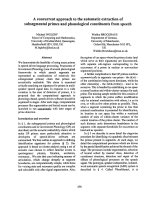A Thesis Submitted To The Graduate School Of Social Sciences Of Middle East Technical University
Bạn đang xem bản rút gọn của tài liệu. Xem và tải ngay bản đầy đủ của tài liệu tại đây (4.63 MB, 167 trang )
MARKETING DEMOGRAPHICS, ADVERTISING SEMIOTICS:
THE CASE OF AKŞAM NEWSPAPER
A THESIS SUBMITTED TO
THE GRADUATE SCHOOL OF SOCIAL SCIENCES
OF
MIDDLE EAST TECHNICAL UNIVERSITY
BY
M. ASLI BAKAN
IN PARTIAL FULFILMENT OF THE REQUIREMENTS FOR THE DEGREE OF
MASTER OF SCIENCE
IN
THE DEPARTMENT OF SOCIOLOGY
DECEMBER 2003
Approval of the Graduate School of Social Sciences
___________________
Prof. Dr. Sencer Ayata
Director
I certify that this thesis satisfies all the requirements as a thesis for the degree of
Master of Science.
___________________
Prof. Dr. Yusuf Ziya Özcan
Head of Department
This is to certify that we have read this thesis and that in our opinion it is fully
adequate, in scope and quality, as a thesis for the degree of Master of Science.
___________________
Assoc. Prof. Dr. Meyda Yeğenoğlu Mutman
Supervisor
Examining Committee Members
Assoc. Prof. Dr. Meyda Yeğenoğlu Mutman
__________________________
Asst. Prof. Dr. Ayşe Gündüz Hoşgör
__________________________
Asst. Prof. Dr. John Grosh
__________________________
ABSTRACT
MARKETING DEMOGRAPHICS, ADVERTISING SEMIOTICS:
THE CASE OF AKŞAM NEWSPAPER
Bakan, M. Aslı
M.S., Department of Sociology
Supervisor: Assoc. Prof. Dr. Meyda Yeğenoğlu Mutman
December 2003, 151 pages
The main aim of this thesis is to discuss conflicting opinions about the existence,
targets and the system of advertising and to examine its effects on purchasing
behaviors. Another important aim of the study is to demonstrate that advertising is an
important but not the sole factor which increases the sales of a product. The study
focuses on the relationship between the capitalist industry and consumers’ purchasing
decisions. It discusses the effects of marketing strategies on consumer behaviors and
purchasing preferences. The interaction between the symbolic representations of
commodities’ brand names and consumption decisions are evaluated and the basic
arguments of critics and advertisers about the system of advertising are discussed. In
addition, variables other than advertising that influence consumer behaviors are
iii
examined and the importance of advertising in modern marketing is presented. To
understand the messages in today’s advertisements deeply, semiology as one of the
most important methodologies of decoding advertisements, the basic advertising
formats and the language of advertising are evaluated. The question of how meaning
is reconstituted both by advertisers and the viewers of messages is discussed. The
study also entails a case study in which Akşam’s re-launch advertising campaign is
evaluated. Akşam’s brand and image perception before and after the advertising
campaign is examined. After this evaluation, the success of an advertising campaign
in accordance with its advertising strategy is discussed.
Key Words: Marketing, Advertising, Advertisement, Semiology, Media, Newspaper,
Consumption, Consumer Behavior, Purchasing Behavior, Sales, Brand Name.
iv
ÖZ
PAZARLAMA VERİLERİ, REKLAMDA GÖSTERGE BİLİM:
AKŞAM GAZETESİ ÖRNEK OLAY ÇALIŞMASI
Bakan, M. Aslı
Yüksek Lisans Tezi, Sosyoloji Bölümü
Tez Danışmanı: Doç. Dr. Meyda Yeğenoğlu Mutman
Aralık 2003, 151 sayfa
Bu tezin temel amacı, reklamın varoluş nedenleri, amaçları ve genel olarak sisteminin
nasıl işlediği konusundaki karşıt görüşleri karşılaştırmalı olarak tartışmak ve satınalma
davranışları üzerindeki etkilerini incelemektir. Çalışmanın bir diğer amacı ise,
reklamın satışı arttırıcı önemli fakat tek unsur olmadığını göstermektir. Bu çalışma
kapitalist endüstri ile tüketicilerin satın alma davranışları arasındaki ilişki üzerinde
odaklanmaktadır.
Çalışma,
pazarlama
stratejilerinin
tüketicilerin
satın
alma
davranışları ve tüketim tercihlerine etkisini tartışmaktadır. Markaların sembolik
değerleri ile tüketim kararları arasındaki etkileşim incelenmekte ve reklamı
eleştirenler ile reklamcıların, reklamın sistemi konusundaki temel argümanları
tartışılmaktadır. Bunun yanısıra, tüketici davranışlarını etkileyen reklam dışındaki
v
faktörler incelenmekte ve reklamın modern pazarlama içindeki önemi sunulmaktadır.
Günümüz reklamlarındaki mesajları derinlemesine anlayabilmek için, en önemli
reklam metodolojilerinden biri olan semiyoloji, temel reklam formatları ve reklam dili
incelenmektedir. Reklam içindeki mesajların anlamının tüketici ve reklamcılar
tarafından nasıl oluşturuldukları ve çözümlendirildikleri konusu tartışılmaktadır. Bu
çalışma ayrıca Akşam Gazetesi relansman kampanyasının incelendiği bir örnek olay
çalışmasını da kapsamaktadır. Reklam kampanyası öncesi ve sonrası Akşam’ın marka
ve imaj algılanması değerlendirilmektedir. Bu incelemenin ardından, Akşam’ın yeni
pazarlama stratejisinin temel amaçlarına göre planlanan reklam kampanyasının
başarısı tartışılmaktadır.
Anahtar Kelimeler: Pazarlama, Reklamcılık, Reklam, Semiyoloji, Medya, Gazete,
Tüketim, Tüketici Davranışları, Satın Alma Davranışları, Satış, Marka.
vi
To my parents and my fiance, Gökalp
vii
ACKNOWLEDGEMENTS
I would like to express my deepest gratitude to my thesis advisor Assoc. Prof. Dr.
Meyda Yeğenoğlu Mutman for her guidance, comments and support throughout the
difficult process of writing this thesis. I would also like to extend my thanks to the
thesis jury members, Assoc. Prof. Dr. Ayşe Gündüz Hoşgör and Assoc. Prof. Dr. John
Grosh for their invaluable comments.
Thanks are also due to my colleagues for their help and the Managers of Akşam for
their support.
Last but not least, my heartfelt thanks go to my family for their understanding and to
dearest Gökalp Gökulu, for the support, encouragement and great help he has given to
me during this study.
viii
I hereby declare that all the information in this document has been obtained and
presented in accordance with academic rules and ethical conduct. I also declare that,
as required by these rules and conduct, I have fully cited and referenced all material
and results that are not original to this work.
Date: December 04, 2003
Signature:
ix
TABLE OF CONTENTS
ABSTRACT …………………………………………………………………
iii
ÖZ ……………………………………………………………………………
v
ACKNOWLEDGEMENTS
…………………………………………………
vii
TABLE OF CONTENTS ……………………………………………………
viii
LIST OF TABLES …………………………………………………………..
xv
LIST OF FIGURES ………………………………………………………….
xvi
CHAPTER
1.
INTRODUCTION
……………………………………………….
1
2.
TODAY’S CONSUMERISM AND THE MIND OF THE
CONSUMER ……………………………………………………..
5
2.1 Types of Commodities in the World of Marketing ………….
8
2.2 Borders of Freedom of Choices in the Capitalist Industry …..
11
2.3 Agents and Reasons of Manipulation ………………………..
14
2.4 Connection between the Industrial Society and Consumers
…
17
2.5 The Effect of Marketing Strategies on Purchasing Decisions …
20
2.6 Interaction Models between Consumers and Commodities
….
24
2.6.1 Interaction Model 1 – An Identical Relation ………….
25
x
2.6.2 Interaction Model 2 – Commodity Driven Identity ……
2.6.3
3.
Interaction Model 3 – A Reciprocal Relationship
Between Consumers and the Industry ………………...
30
A DISCUSSION OF DIFFERENT APPROACHES TO
ADVERTISING …………………………………………………...
33
3.1 Criticisms against Advertising ………………………………..
37
3.1.1 Why does Advertising Exist?
4.
28
……………………….…
38
3.1.2 How does Advertising Create Demand? ………………
41
3.1.3 What Effects does Advertising Have on the Society? …
46
3.2 Advertising from its Creators’ and Defenders’ Points of View …
50
3.2.1 The Myth of Manipulation ……………………………..
51
3.2.2 The Informative Characteristics of Advertising ……….
52
EVALUATION OF ADVERTISING AS THE MOST POWERFUL
MARKETING STRATEGY ……………………………………….
56
4.1 Variables Affecting Consumer Behavior ………………………
57
4.1.1 Cultural Factors
…………………………………………
58
4.1.1.1 Culture
…………………………………………
58
4.1.1.2 Subculture ……………………………………..
59
4.1.1.3 Social Class
……………………………………
60
…………………………………………..
62
4.1.2.1 Groups …………………………………………
62
4.1.2.2 Family ………………………………………….
64
4.1.2.3 Roles and Status
……………………………….
64
4.1.3 Personal Factors ………………………………………..
65
4.1.2 Social Factors
xi
4.1.3.1 Age ……………………………………………
65
4.1.3.2 Marital Status
………………………………….
66
4.1.3.3 Occupation ……………………………………..
66
4.1.3.4 Economic Status ……………………………….
67
4.1.3.5 Life Style ……………………………………...
67
4.1.3.6 Personality and Self-Concept …………………
68
4.1.4 Psychological Factors …………………………………
68
4.1.4.1 Motivation ……………………………………....
68
4.1.4.2 Perception …………………………………….
70
4.1.4.3 Learning ………………………………………
72
4.1.4.4 Beliefs and Attitudes ………………………….
72
4.2 Types of Purchasing Behavior
………………………………..
4.2.1 Complex Buying Behavior
74
……………………………
74
4.2.2 Dissonance-Reducing Buying Behavior ………………
75
4.2.3 Habitual Buying Behavior …………………………….
76
4.2.4 Variety-Seeking Buying Behavior …………………….
77
4.3 The Role of Advertising as a Marketing Strategy …………...
77
4.4 The Aims of Advertising as a Marketing Strategy
…………..
80
4.4.1 Raising Sales of the Product …………………………..
80
4.4.2 Creating Brand Image, Awareness and Loyalty ……….
82
4.4.3 Correcting Negative Impressions about the Company or
the Product Image ………………………………………
83
4.4.4 Creating Competitive Advantage for the Company or
the Product …………………………………………….
83
xii
4.4.5 Informing and Educating Consumers ………………….
4.4.6 Reaching the Masses ……………………………………
5.
DEVELOPING AN ADVERTISING STRATEGY AND DECODING
ADVERTISING …………………………………………………… 87
5.1 Developing an Advertising Program
………………………….
89
5.2 Semiology and the Study of Advertising ……………………..
94
5.2.1 The Use of Semiology in Advertising
………………...
95
5.2.2 Decoding Advertisements with the Science of
Semiology ……………………………………………..
98
5.2.3 The Weaknesses of Semiology as a Method for the
Study of Advertising ………………………………….
102
5.3 Basic Advertising Formats …………………………………..
103
5.3.1 The Product-Information Format
……………………..
103
…………………………...
104
……………………………..
107
…………………………………
107
5.4 The Language of Advertising ………………………………
110
5.4.1 Double Meaning …………………………………….
111
THE RE-LAUNCH ADVERTISING CAMPAIGN OF AKŞAM ...
114
6.1 Newspapers’ Reader Group Segmentation ………………..
117
6.2 Akşam’s Reader Profile and Brand Image Perception before
the Advertising Campaign …………………………………
122
6.2.1 A Brief History of Akşam ……………………………
122
6.2.2 Akşam’s Brand Image Reseach ……………………..
123
6.3 Developing Akşam’s Re-Launch Advertising Strategy ……
128
5.3.2 The Product-Image Format
5.3.3 The Personalized Format
5.3.4 The Lifestyle Format
6.
84
86
xiii
6.3.1 Akşam’s New Editorial and Marketing Policy ………
6.3.2 The New Target Consumer Group of Akşam ……….
128
129
6.3.3 The Aims of the Advertising Campaign …………….
130
6.4 Akşam’s Outdoor and Printed Advertising Campaign ……..
131
6.4.1 Objectives of the Campaign …………………………
132
6.4.2 Decoding of the Advertisements of Akşam ………….
133
6.5 The Effectiveness of the Re-Launch Advertising Campaign
of Akşam ……………………………………………………
136
6.5.1 Readership Profile of Akşam before and after the
Advertising Campaign ………………………………..
136
6.5.2 Circulation Rates of Akşam before and after the
Advertising Campaign ………………………………..
138
6.5.3 Raising the Income of Akşam with New Advertorial
Customers ……………………………………………..
139
CONCLUSION ................................................................................
141
BIBLIOGRAPHY ……………………………………………………………..
149
7.
xiv
LIST OF TABLES
TABLE
1. Durable Consumer Goods and their Indicators …………………………
119
2. Educational Status of Readers ………………………………………….
119
3. Occupational Status of Readers …………………………………………
120
4. Socio-economic Status of Readers
5. Comparative Gender of Readers
……………………………………… 121
………………………………………… 137
6. Comparative Ages of Readers …………………………………………... 137
7. Comparative Socio-economic Status of Readers
………………………..
138
8. Comparative Sales ………………………………………………..……... 138
9. Comparative Advertorial Rates …………………………………………. 139
xv
LIST OF FIGURES
FIGURE
1. Subliminal Advertising: Camel Cigarettes
………………………………
44
2. Subliminal Advertising: Mercedes Automobile …………………………
44
3. Semiology in Advertising: Free Lander …………………………………
98
4. Decoding Advertisements: Chanel No.5 ……………………………….. 100
5. The Product Information Format: İstikbal Perform …………………….. 105
6. The Product Image Format: Clinique …………………………………… 106
7. The Personalized Format: Mercedes-Benz
……………………………… 108
8. The Lifestyle Format: J&B ……………………………………………… 109
9. Double Meaning: Volkswagen New Beetle
10-15. Akşam Advertising Campaign
…………………………….. 112
……………………………………… 134
xvi
CHAPTER 1
INTRODUCTION
In our day, the role of advertising is increasing tremendously. Especially in
industrial societies, advertising has become one of the most effective social
communication tools.
Without any doubt, messages given in advertisements
deeply affect us and our purchasing behaviors.
In capitalist societies, the relationship between the industry and consumers is quite
complicated; on one hand, consumers are allowed to interpret industry's messages
on their own, on the other hand, the industry encourages consumers to participate
actively in the interaction. It is the industry, however, that dominates the
communicative processes and even though it may be possible for consumers to
formulate their own needs and desires through commodities, their freedom is
eventually accommodated into the capitalist system. Therefore, advertising as one
of the most important weapons of the capitalist system is highly criticized by many
people for creating false needs which people strive to satisfy and thus encouraging
people to consume more.
1
According to critics, while the primary function of advertising should be to
introduce a wide range of consumer goods to the public and thus to support the
free market economy, over the years it has become more and more involved in the
manipulation of social values and attitudes and less concerned with the
communication of essential information about goods and services. Critics claim
that advertisements work only for creating new needs and consumption patterns to
raise the sales of the products. On the other hand, advertisers insist that rather than
creating false needs, they discover the new needs of the consumers and inform
them about ways of satisfying these needs by presenting new products.
People who criticize advertising in its current form argue that advertising is an
irrational system, which appeals to our emotions and to our anti-social feelings
which have nothing to do with the goods on offer. Advertisements usually suggest
private acquisition and competitiveness as a primary goal in life. It is said that
today’s consumer economy makes people greedy and materialistic, and advertising
promotes this situation. On the other hand, those who defend advertising suggest
that it is economically necessary and has brought many benefits to the society and
advertisers also claim that people are perfectly free to ignore their advertisements
and that commercials cannot be said to brainwash or manipulate people because
there are some advertising campaigns which fail to attract consumers.
This thesis discusses whether advertising creates false needs and encourages
people to consume more by changing existing consumption patterns, as some
critics claim, or whether it contributes to the society’s well-being and raises
2
people’s standards of living by encouraging the sales of mass-produced goods and
informing people about them. This question is worth discussing because in today’s
world advertising is not just business expenditure; it is an integral part of modern
culture.
It would be correct to say that consumer goods and advertising have brought
comfort and pleasure to a large number of people and this is not morally bad. In a
complex society, consumer goods are both necessary and important and, on the
whole, they have been a much welcome development of the modern world.
However along with commodities, people need information about them such as
their prices, functions, durability, distribution channels, and quality. This kind of
information will help consumers to make wise and rational consumption choices.
At this point, the crucial question is whether consumer advertising gives people
enough, or indeed any, accurate information.
In this respect, this thesis will examine the two opposing approaches to
advertising; namely, the critics’ claim that the only aim of advertising is to
increase sales and consumption by manipulating people and the advertisers’ point
of view that the primary aim of advertising is to maximize consumer benefits by
informing them and presenting a large amount of alternatives. The whole system
of advertising will be analyzed in detail to comprehend how the system works.
3
Therefore, the main focus of this thesis is to discuss the contrasting opinions about
the existence and the system of advertising, along with its effects on purchasing
behaviors. Another important aim of the study is to demonstrate that advertising is
an important but not the only factor which brings an increase in the sales of a
product.
4
CHAPTER 2
TODAY’S CONSUMERISM AND THE MIND OF THE
CONSUMER
In the analysis of today’s consumerism two different approaches are prominent.
One is called the “subjective approach” by Herbert Blumer, which treats
consumers and industry separately and studies the decision-making processes of
either consumers or companies in a given environment. To illustrate, according to
the subjective approach, marketers plan to launch a product not knowing what
consumers really want or need. Similar to the marketers, consumers buy products
based on their own rational decisions.
In this respect, consumers do not consider the information put forward by
marketers and advertisers. In general, this approach portrays consumers as free
agents in a marketplace and welcomes consumer activism in the consumption
process. According to this, consumers carefully examine the quality and price of
products when they decide to purchase it. They regard consumption not as a mode
of cultural activity but rather as a rationalized process of fulfilling their desires.
Therefore, consumer’s purchasing decisions are not affected or manipulated by
marketing or advertising strategies (Blumer, 1969, p.25-45).
5
On the contrary, the other approach emphasizes the interaction between consumers
and the industry based on the premise that advertisers can affect consumers’
purchasing decisions through the interaction of products. According to this
approach, the advertising mechanism works in an unconscious and subliminal way
because its effects do not seem open to introspection. Such approaches are
associated with the “dark and manipulative” view of advertising.
In this respect, consumers cannot escape from the systematic constraint of
capitalism insofar as they depend upon commodities in the expression of their
consumption behaviors (Sutherland & Sylvester, p.5, 2000). There is a sharp
contrast with the subjectivist observations at this point as this approach
undermines the belief that consumers are free agents in the market.
According to this argument, manipulation begins not at the point where consumers
choose different brands of the same product presented by the capitalist industry but
at the point where the industry persuades consumers to choose a certain brand of
the given product. For instance, according to this approach, the capitalist industry
makes people believe that they need to have a cellular phone and they are given
the “freedom” to choose the brand they like from the cellular phone market.
However, having a cellular phone may not be a real need for the consumer in the
first place as it is not a vital necessity for everyone to have a cellular phone.
On the other hand, according to the subjectivist approach, having a cellular phone
is a real necessity in the era that we live because they make our business and
6
personal lives easier. In this respect, the capitalist industry does not create but
discover consumers’ new needs and presents alternative products to satisfy their
needs. Marketers and advertisers in turn present these products to consumers and
inform them about the qualities and functions of the products by using different
strategies. There is no manipulation in this process; consumers are free to purchase
cellular phones and they choose to do so not because they are manipulated by
marketers but because they believe that cellular phones will make their lives
easier.
In the light of these two opposite views, this chapter focuses particularly on the
relationship between consumers’ purchasing decisions and the importance of
symbolic significance of commodities, which are created by marketers and
advertisers.
This chapter serves as a basis for the following chapter that will discuss the
opposing theories about the advertising industry by evaluating today’s
consumerism dynamics. The brand name is a powerful tool for the industry to
associate commodities with consumers because it symbolizes various elements of
commodities. Therefore, consumers have relative liberty in finding the association
between their rational needs and the commodities that they purchase.
Even though it may be possible for consumers to consume in accordance with their
own rational needs, their freedom is eventually restricted in the capitalist system.
In this sense, this chapter examines the functional aspect of commodities as a
7
communicative tool. In the capitalist society, the power relation between the
industry and consumers is quite complicated; on the one hand, consumers are
allowed to interpret industry's messages freely, on the other hand, the industry
encourages consumers to actively participate in the interaction. It is the industry,
however, that dominates the communicative processes and even though it may be
possible for consumers to formulate their own needs and desires through
commodities, their freedom is eventually accommodated into the capitalist system.
In other words, this chapter discusses the question why people consume. Do they
consume to satisfy their own rational needs according to their own preferences or
do they act on created or false needs, which are formed by marketers and
advertisers? Moreover, this chapter will examine the argument that some new
needs like cellular phones are actually created by marketers. Do they become a
real necessity for the consumer or are consumers just persuaded or even
manipulated? To understand the relationship between consumers and the capitalist
industry, firstly it is necessary to observe the types of commodities in the world of
marketing.
2.1 Types of Commodities in the World of Marketing
Before discussing the two opposite views which are mentioned briefly in the
introduction, this section will focus on Phillip Kotler’s specification of
commodities in order to understand the strategies of marketers. Marketers and
advertisers apply different strategies for every product. Therefore, they segment
the products as they segment the consumers, which will be elaborated on in the
8
following sections, to achieve their aims more easily. Phillip Kotler, an American
marketing advisor, classifies commodities into four categories (Kotler, 1994,
p.436):
1. Convenience Goods: These commodities are what customers purchase
frequently, immediately and with a minimum effort, such as tobacco
products. The brand-name loyalty is very powerful for convenience goods
because most consumers do not want to change their habits. Therefore it is
very hard for marketers to launch a new convenience good because other
competitors have already shared the market. To possess a piece of this
market, the new product’s unique selling purpose – the distinguishing
points of the product from its competitors – must be very powerful.
2. Shopping Goods: This type of commodities includes furniture or clothing
and major appliances, which customers characteristically compare on such
bases as suitability, quality, price and style.
3. Unsought Goods: This type of commodities is ones that consumers either
do not know about or do not normally consider buying. The classic
examples are life insurance or gravestones.
4. Specialty Goods: These commodities are the ones with unique
characteristics and/or brand identification for which a significant group of
buyers are habitually willing to make a special purchasing effort, such as
branded goods like cars, men’s suits, women’s jewelry, newspapers, or
cellular phones. For this type of products, the important thing is not their
price or quality but the symbolic representation of their brand name. No
9









